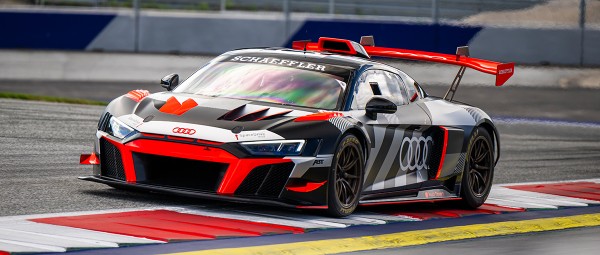Schaeffler innovation taxi makes technological progress tangible
Technological progress is not just one of the driving forces of motorsport – it is also what made Schaeffler a pioneer in the area of mobility. With the DTM innovation taxi, the 2023 season of the DTM now sees Schaeffler bring a race taxi that showcases technological advances at racing speed to the track.
- Title holder drives Audi R8 LMS GT2 Schaeffler innovation taxi
- Motorsport as a catalyst for new technologies
- Variable steering angle: Successful tests at the Hockenheimring
- Debut: Schaeffler rear wheel steering in a GT racing car for the first time
- Schaeffler opts for e-fuels in the DTM innovation taxi
- Sport Bild Motorsport Innovations Award honours DTM innovation taxi
Title holder drives Audi R8 LMS GT2 Schaeffler innovation taxi
DTM champion Mike Rockenfeller explains the Steer-by-Wire steering system in the video and takes spectacular laps in the innovation taxi.
The DTM innovation taxi is an approved GT2 racing car: the Audi R8 LMS GT2. It is in action at every DTM race weekend in 2025 and is driven by well-known racing drivers like Markus Winkelhock and Mike Rockenfeller. Rockenfeller won the driver’s title in the touring car series with the Schaeffler Audi in 2013. His other successes include winning the 24 hours of Le Mans in 2010.
It isn’t only the racing drivers who have the opportunity to experience fascinating new technologies in action first hand. The Schaeffler innovation taxi is also taking over the role of DTM race taxi, meaning it gives its guests the opportunity to drive in a real DTM car, while also making technological progress tangible. It also meets the highest safety requirements.
Motorsport as a catalyst for new technologies
As the carrier vehicle for innovative technical ideas and their implementation, the DTM race taxi is the epitome of what Schaeffler embodies as the innovation partner of the DTM. It focuses Schaeffler’s technological expertise on a single vehicle and shows which innovations may soon be making their way onto the racetrack and the road.
The Audi R8 GT2 taxi is equipped with steer-by-wire technology. Motorsport is an ideal training platform for further developing Space Drive, the steer-by-wire technology from Schaeffler. The data collected during race weekends will be evaluated alongside the feedback from the drivers. This will provide important insights for the use and further development of the Space Drive system in series production.

Variable steering angle: Successful tests at the Hockenheimring
One of these developments, which benefits both motorsport and production vehicles, was tested by Markus Winkelhock at the Hockenheimring in 2023: the individually configurable steering angle of the car. While the force feedback unit in the steer-by-wire system ensures that the innovation taxi’s steering reports back the desired counterforce, depending on the driver, the steering ratio can also be directly influenced via the actuator – and on an entirely individual basis, even during the journey.
The effect is impressive. Markus Winkelhock demonstrated this in the hairpin at the Hockenheimring. Here, drivers must turn nearly 180 degrees. Usually, this requires the drivers to rotate the steering wheel about 180 degrees. However, a higher steering ratio means a 90-degree rotation is sufficient to negotiate this point on the track without any issues. It is no longer necessary to change one’s grip.
Easier parking and manoeuvring
While this kind of tight corner crops up relatively rarely at racetracks, they appear far more regularly in rallying. A Schaeffler test on ice and snow showed: with an individually configurable steering angle, rally drivers can also take particularly tight corners at top speed, when it would otherwise be necessary to apply the handbrake. The result is faster times and less strain for the drivers.
The Schaeffler system also has particularly big benefits in conventional road traffic. Particularly in situations that many road users view as being especially laborious. For example, a car with a configurable steering angle makes it possible to manoeuvre and park with far less steering effort. This makes life easier and more comfortable for drivers.
Steer-by-wire, steering without a mechanical steering column, is one of the key technologies on the road to autonomous driving and has many other advantages.

Debut: Schaeffler rear wheel steering in a GT racing car for the first time
The rear axle can steer both parallel and in the opposite direction to the front axle.
Last season, the DTM innovation taxi once again brought to life just how closely motorsport and series development are linked at Schaeffler. It was the first touring sports car to line up with rear-wheel steering.
The Schaeffler system made its debut in production vehicles in 2023. Its technological edge has a positive effect on both the road and the racetrack. The planetary roller gear sets the Schaeffler rear wheel steering apart from other manufacturers’ systems, which traditionally use a trapezoidal screw drive.
While trapezoidal screw drives use spindles, the Schaeffler system uses rollers, also known as "planets", as rolling elements. It thus combines the technology of a rolling bearing with that of a planetary gearbox. This leads to numerous advantages. Among other things, in the car the Schaeffler innovation achieves a significantly higher level of efficiency, is lighter and reduces friction as well as the reaction time of the system.
The new steering system for the rear axle makes vehicles easier to handle in city traffic, more stable when changing lanes, and more manoeuvrable when parking. At the racetrack the system makes the vehicle more agile at lower speeds, such as when accelerating out of narrow bends. Since the rear wheels steer in the opposite direction to the front wheels, the race taxi turns the right way into the corner exit earlier on, which facilitates earlier acceleration. When the rear wheels steer in the same direction as the front wheels, the rear wheel steering stabilises the vehicle. This prevents oversteer and enables corners to be negotiated faster and more safely.
In summary: The vehicle becomes easier to drive, is easier to control, and enables potentially faster laps. In addition, the Schaeffler system leads to slower tyre degradation and enables chassis tuning with greater mechanical traction. Markus Winkelhock was enthusiastic after his first drive with the rear-wheel steering system: “You can really feel the effect of the rear wheel steering. The car is much easier to manage, particularly in hairpin bends and when accelerating out of turns. This has clear advantages on the track.”
Schaeffler opts for e-fuels in the DTM innovation taxi
The DTM innovation taxi also gives Schaeffler the ideal vehicle, with which to demonstrate the performance and sustainability of alternative fuels. As of the DTM race weekend at the Lausitzring in the 2023 season, the Audi R8 LMS GT2 is powered by synthetic fuels, also known as e-fuels.
E-fuels are synthetic fuels produced using renewable energy, which ideally comes from regenerative energy sources. The advantage being that they facilitate carbon neutral running of combustion engines. And these sustainable fuels benefit both new cars and every car with a combustion engine currently being utilised. This is approximately 1.3 billion vehicles.
In addition, Schaeffler uses high-performance lubricants from Lubrican in the DTM Innovation taxi. They are 100% fossil-free, in other words they do not contain any mineral oils. Only CO2-neutral energy is used in their production. In total, the lubricants used in the DTM Innovation taxi generate up to 72% less CO2 than conventional lubricants.
Currently, Schaeffler predicts that 40 percent of vehicles around the world will be fully electrified by 2030. A further 40 percent will have a partially electric propulsion system and continue to use highly efficient internal combustion engines developed in line with the latest emissions standards. The remaining 20 percent will use a pure highly efficient internal combustion engine. It is for this reason that Schaeffler is adopting an approach based on a wide range of drive systems and offers the right solution for every application. These include partial and fully electrified drive systems as well as fuel cell systems and the evolution of efficient internal combustion engines, which thanks to e-fuels remain an important aspect of more environmentally friendly mobility.

Sport Bild Motorsport Innovations Award honours DTM innovation taxi
The DTM innovation taxi combines numerous technologies and innovations from Schaeffler in one fascinating vehicle. It thus embodies everything that characterises Schaeffler as a motion technology company.
The DTM innovation taxi succeeds in making technology that is difficult to grasp - because it is not visibly installed in the vehicle - an emotional experience. Schaeffler 2023 not only impressed the more than 100 guests in the cockpit of the racing taxi, but also the experts. The jury of the magazine Sport Bild presented the coveted Sport Bild Motorsport Innovations Award 2023 to Schaeffler's DTM innovation taxi.


